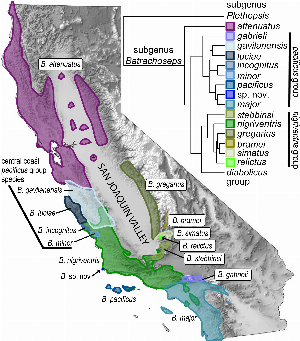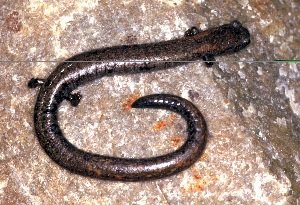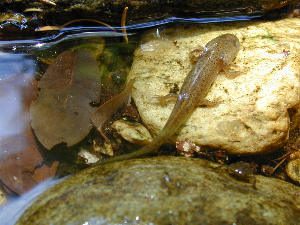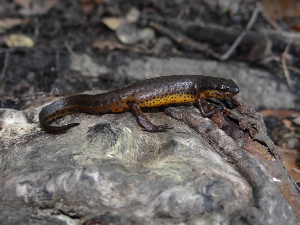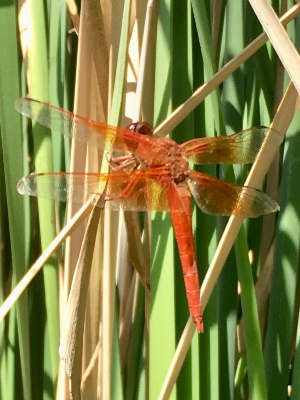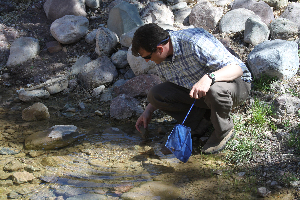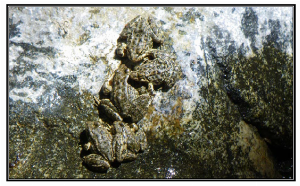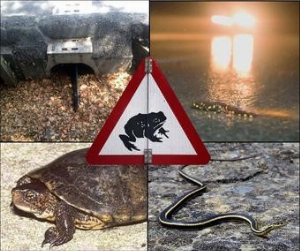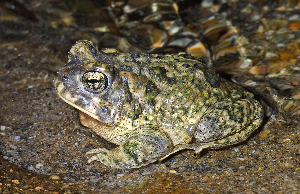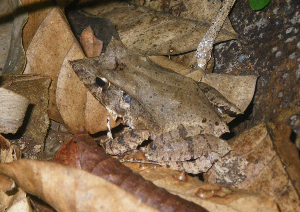Search ARMI Database
Search term(s)
Contribution Number
Search Results
106 record(s) found.
Papers & Reports The influence of species life history and distribution characteristics on species responses to habitat fragmentation in an urban landscape
2. We aimed to identify patterns in species biogeography in an urbanized landscape to understand anthropogenic effects on vertebrate communities and identify species that are more sensitive or resilient to landscape change.
3. We investigated patterns in species richness and species responses to fragmentation in southern Californian small vertebrate communities using multispecies occupancy models and determined factors associated with overall commonness and sensitivity to patch size for 45 small vertebrate species both among and within remaining non-developed patches.
4. In general, smaller patches had fewer species, with amphibian species richness being particularly sensitive to patch size effects. Mammals were generally more common, occurring both in a greater proportion of patches and a higher proportion of the sites within occupied patches. Alternatively, amphibians were generally restricted to larger patches but were more ubiquitous within smaller patches when occupied. Species range size was positively correlated with how common a species was across and within patches, even when controlling for only patches that fell within a species’ range. We found sensitivity to patch size was greater for more fecund species and depended on where the patch occurred within a species’ range. While all taxa were more likely to occur in patches in the warmer portions of their ranges, amphibians and mammals were more sensitive to fragmentation in these warmer areas as compared to the rest of their ranges. Similarly, amphibians occurred at a smaller proportion of sites within patches in drier portions of their ranges. Mammals occurred at a higher proportion of sites that were also in drier portions of their range while reptiles did not differ in their sensitivity to patch size by range position.
5. We demonstrate that taxonomy, life history, range size, and range position can predict commonness and sensitivity of species across this highly fragmented yet biodiverse landscape. The impacts of fragmentation on species communities within an urban landscape depend on scale, with differences emerging among and within species and populations.
Papers & Reports The Coyote Mountains’ Desert Snail (Sonorelix harperi carrizoensis), a Lazarus Species with the First Documentation of Live Individuals
News & Stories Urban Southern California is a Center of Diversification for Salamander Lineages
The Southern California Biodiversity Hotspot has a complex geological history and has a human population of about 24 million people. A recent study of genetic diversity across salamanders that occur here found high levels of localized diversity representing ancient mitochondrial lineages. Several of these lineages are very geographically limited and occur only within this urban matrix. Each of the three National Parks (Channel Islands National Park, Santa Monica Mountains National Recreational Area, and Cabrillo National Monument) in this southern California landscape will be important for the long term persistence of unique lineages that are almost micro-endemics to just these park units. Various Bureau of Land Management lands in this regional also house highly divergent lineages that could serve as conservation targets. Lastly, this work provides further support for the importance of the continued US Fish and Wildlife program of Habitat Conservation Planning within this Biodiversity Hotspot for conserving undescribed ancient patterns of genetic diversity.
Papers & Reports Slender salamanders (genus Batrachoseps) reveal Southern California to be a center for the diversification, persistence, and introduction of salamander lineages
Methods. We sequenced the mitochondrial gene cytochrome b from a geographically comprehensive sampling of the mitochondrial lineages of B. major and B. nigriventris that are endemic to southern California. We used phylogenetic analyses to characterize phylogeographic structure and identify mitochondrial contact zones. We also included the San Joaquin Valley samples to test whether they resulted from introductions. We used a bootstrap resampling approach to compare the strength of isolation-by-distance in both Batrachoseps species and four other salamander species with which they co-occur in southern California.
Results. The northern lineage of B. major harbors at least eight deeply differentiated, geographically cohesive mitochondrial subclades. We identify geographic contact between many of these mtDNA lineages and some biogeographic features that are concordant with lineage boundaries. Batrachoseps nigriventris also has multiple deeply differentiated clades within the region. Comparative analyses highlight the smaller spatial scales over which mitochondrial divergence accumulates in Batrachoseps relative to most other salamander species in southern California. The extralimital populations of Batrachoseps from the San Joaquin Valley are assigned to B. major based on their mitochondrial haplotypes and are shown to result from at least two independent introductions from different source populations. We also suggest that B. major on Catalina Island, where it is considered native, may be the result of an introduction. Some of the same traits that facilitate the build-up of deep phylogeographic structure in Batrachoseps likely also contribute to its propensity for introductions, and we anticipate that additional introduced populations will be discovered.
Papers & Reports Multi-Taxa Database Data Dictionary
Papers & Reports Reptile and amphibian diversity and abundance in an urban landscape: Impacts of fragmentation and the conservation value of small patches.
Papers & Reports Historical museum collections and contemporary population studies implicate roads and introduced predatory bullfrogs in the decline of western pond turtles
Papers & Reports Changes in capture rates and body size among vertebrate species occupying an insular urban habitat reserve
Papers & Reports Amphibian responses in the aftermath of extreme climate events
of the century. One major factor that will contribute to these extinctions is extreme climatic events.
Here, we show the ecological impacts of recent record warm air temperatures and simultaneous peak
drought conditions in California. From 2008–2016, the southern populations of a wide-ranging endemic
amphibian (the California newt, Taricha torosa) showed a 20% reduction to mean body condition and
significant losses to variation in body condition linked with extreme climate deviations. However,
body condition in northern populations remained relatively unaffected during this period. Range-wide
population estimates of change to body condition under future climate change scenarios within the
next 50 years suggest that northern populations will mirror the loss of body condition recently observed
in southern populations. This change is predicated on latter 21st century climate deviations that
resemble recent conditions in Southern California. Thus, the ecological consequences of climate change
have already occurred across the warmer, drier regions of Southern California, and our results suggest
that predicted climate vulnerable regions in the more mesic northern range likely will not provide
climate refuge for numerous amphibian communities.
Papers & Reports Batrachochytrium salamandrivorans (Bsal) not detected in an intensive survey of wild North American amphibians
Papers & Reports Effect of amphibian chytrid fungus (Batrachochytrium dendrobatidis) on apparent survival of frogs and toads in the western USA
Papers & Reports Identifying management-relevant research priorities for responding to disease-associated amphibian declines
News & Stories Invasive crayfish wreck havoc on amphibians in southern California, and now its clear they also increase mosquito larvae.
Previous work by ARMI scientists have shown the important impact of invasive crayfish (Procambarus clarkii) on endangered and threatened amphibian species in southern California (https://onlinelibrary.wiley.com/doi/abs/10.1111/cobi.13198 ). New published research has shown that these non-native predators may increase disease vectors (e.g. mosquitoes) through predation on native predators of these vectors such as dragonfly nymphs (https://www.usgs.gov/center-news/invasive-crayfish-increase-number-mosquitoes-southern-california-mountains). This work has also been highlighted in a recent National Geographic report on the study (https://www.nationalgeographic.com/animals/2018/08/swamp-crayfish-crawfish-mosquitoes-disease-animals/).
Papers & Reports The relative efficiency of native and non-native aquatic species as predators of potential disease vectors: Invasive crayfish enhance the survival of mosquitoes
Mountains, situated in a global biodiversity hotspot, is an area of conservation concern due to climate change, urbanization, and the introduction of non-native species. We examined the effect that non-native crayfish (Procambarus clarkii) have on an existing native predator, dragonfly nymphs (Aeshna sp.) and their mosquito larvae (Anopheles sp.) prey. We used laboratory experiments to compare the predation efficiency of both predators, separately and together, and field data on counts of dragonfly nymphs and mosquito larvae sampled from 13 local streams. We predicted a lower predation efficiency of crayfish compared to native dragonfly nymphs as well as a reduced efficiency of dragonfly nymphs in the presence of crayfish. Dragonfly nymphs were an order of magnitude more efficient mosquito predators compared to crayfish and dragonfly
nymphs suffered reduced efficiency in the presence of crayfish. Analyses of field count data showed that populations of dragonfly nymphs and mosquito larvae were strongly correlated with crayfish presence in streams, such that sites with crayfish tended to have fewer dragonfly
nymphs and more mosquito larvae. Under natural conditions, it is likely that crayfish reduce the abundance of dragonfly nymphs and their predation efficiency, and thereby, directly and indirectly, lead to higher mosquito populations and a loss of ecosystem services related to disease vector control.
Papers & Reports Quantifying climate sensitivity and climate driven change in North American amphibian communities
News & Stories 1000 Critically Endangered Mountain Yellow-legged Frogs released back into Los Angeles County!
The USGS has been leading the recovery efforts for the Southern Mountain Yellow-legged Frogs (Rana muscosa) since 2000, in partnership with the USFWS, California Department of Fish and Wildlife, US Forest Service, Los Angeles Zoo, San Diego Zoo Global, and other partners. On June 26 and 27, 2018, 1000 tadpoles produced from captive frogs raised at the Los Angeles Zoo were released into the San Gabriel Mountains National Monument for the first time. These were placed into two different watersheds. More releases are scheduled for later in the summer, but this is a pivotal step in the recovery of this species back onto federal lands within its historic habitats.
Los Angeles Times news story at this link: http://www.latimes.com/local/california/la-me-rare-frog-release-20180627-story.html
News & Stories New USGS Study Paves a Path Forward for Amphibians, Reptiles, and Roadways
In a new study, U.S. Geological Survey (USGS) scientists ranked more than 160 species and sub-species of reptiles and amphibians in terms of their vulnerability to vehicle strikes and habitat fragmentation from roadways. Their results are published in the journal Landscape Ecology.
Although most of the public associates vehicle strikes with mammals, reptiles and amphibians can also encounter cars on the road. These animals are often either too small for the driver to notice, or too slow to escape the car's path. Some species also migrate long distances or have relatively large territories, and may need to risk crossing a roadway to access important habitat. Some species avoid roads altogether, which potentially reduces the amount of available habitat and separates populations that would otherwise mix and increase genetic diversity.
Currently, transportation planning agencies like the California Department of Transportation (Caltrans) use underpasses, overpasses, and physical barriers to reduce the negative effects of roadways on wildlife. However, they can't manage these side-effects for every species because of limited funding or resources. Species at highest risk of negative road impacts are difficult to identify due to a lack of available data or research, particularly on reptiles and amphibians. As a result, resource managers had to identify high risk species by professional opinion or by the few studies related specifically to roads.
To help provide Caltrans and other transportation agencies with the information needed to prioritize species for management, USGS researchers used road ecology literature to develop an objective ranking system for 166 species and subspecies of native Californian reptiles and amphibians. In the ranking system, an animal's vulnerability to vehicle strikes or habitat fragmentation depended on the way members of the species used the space around them, and on different aspects of their life history. For instance, species with large home ranges and seasonal migrations were more likely to encounter roads. Likewise, species that took time to reach sexual maturity and had fewer young were more likely to be affected by the loss of members of their population from vehicle strikes. The scientists found that all turtle and tortoise species, 72% of snakes, 50% of frogs and toads, 18% of lizards, and 17% of salamander species in California ranked at "high" or "very high" risk from potential negative road impacts. Species at very high risk included listed Federal or State endangered or threatened species, like the California red-legged frog (Rana draytonii), Mohave desert tortoise (Gopherus agassizii), and the San Francisco gartersnake (Thamnophis sirtalis tetrataenia). Snakes, turtles, and tortoises tended to rank at higher risk for negative road impacts, since many migrate or have large home ranges, tend not to avoid roads, are long lived, and give birth to relatively few young.
Species that use both terrestrial and aquatic habitats may be particularly susceptible to reduced habitat connectivity. The giant gartersnake (Thamnophis gigas), for example, is a semi-aquatic species found in the Central Valley of California. After losing more than 90% of its historical wetland habitats to agriculture and other forms of human development, this federally and state-listed snake now relies on remaining wetlands, rice fields, and agricultural canals for aquatic habitat. Roads separating the species' terrestrial and aquatic habitat could affect its populations. "Overall, this is meant to be a first step in identifying reptile and amphibian species that may be at highest risk from roads within their habitat. We hope this assessment will help transportation planning agencies and species managers by highlighting species that may need special attention. This can include considering further research and implementing terrestrial and aquatic mitigation solutions to reduce mortality and to maintain or enhance population connectivity," says Cheryl Brehme, lead author and biologist with the USGS Western Ecological Research Center.
This research was funded by the USGS and Caltrans. For more information, read the paper online and explore the project webpage on WERC's website. Amphibian research in this study falls within the national, USGS-led Amphibian Research and Monitoring Initiative (ARMI).
Papers & Reports Prioritizing conserved areas threatened by wildfire for monitoring and management
Papers & Reports Multi-scale effects of land cover and urbanization on the habitat suitability of an endangered toad.
both terrestrial and aquatic environments.

